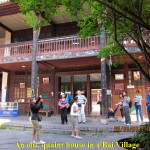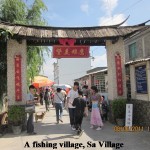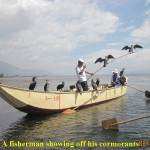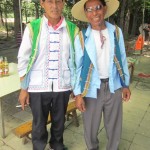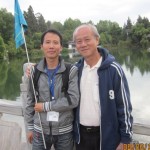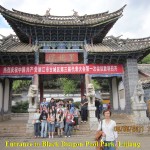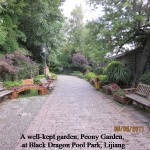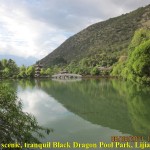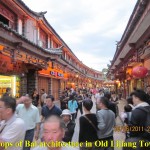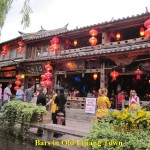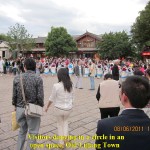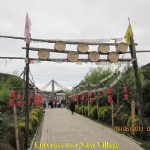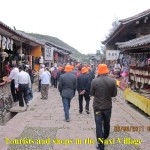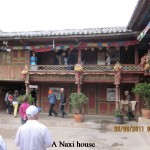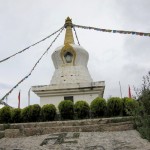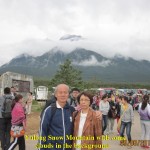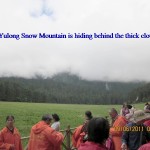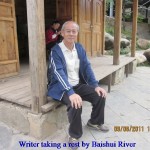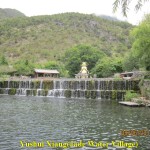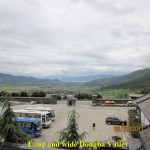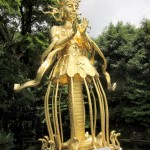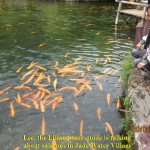Yunnan Travel II (Dali, Lijiang)
(continued from Yunnan Travel I)
Yunnan II
(Dali, Lijiang)
Day 4 Wednesday, June 2011
The Landscape Hotel served two types of food: Chinese and Western. As we had been eating Chinese food the last few days in Yunnan, we took a western breakfast for a change at the hotel. Then we left and went to a Bai village.
Bai Village
In the village, we saw Bai houses made of stones. But there was one old, quaint, large double-storey house that was made of wood. It was a showcase of a Bai residence, tradition and culture. We took a quick tour of the house and were treated to different kinds of Bai tea. Later, we watched two cultural shows in the house. One was a Bai fashion show and the other Bai wedding show.
Sa Village
Having learned something about the Bai culture and tradition at the old house, we left for a fishing village, Sa Village, that is by the Erhai Lake. On arrival, we all boarded a metal boat. The boatman with the help of some of us rowed the boat to a deep spot of the lake. Then a show started.
Cormorants
A man in another boat brought our attention to his birds, cormorants. He was holding a long pole with two birds perching on it. Besides, he had several other birds perching on his boat. At his command, the birds jumped into the lake. But, two stubborn birds refused to enter the water. The man had to used his pole to nudge them into the water.
We could see all the birds swimming, ecstatically, in the water. But, when the man shouted at the birds, they all dived into the water looking for fish. A few minutes later, one of them caught a large one and brought it to the surface for the owner. Later, another large fish was caught, and it was caught by three birds. The owner took the fish and rewarded all the birds with small fish he kept in his boat. One of our tour-members bought one of the fish for RMB 60 and the other fish was bought by a tourist in another boat. Later, we were brought to a lakeside where a Bai lady fried the fish for us.
Dwindling Number of Cormorants
According to a Bai lady on the lakeside, using birds to catch fish is not a common practice anymore, as young Bai people prefer to go to cities to look for more stable jobs. As a result, the number of cormorants has dwindled to less than 100, and they are now used for showing tourists their skill in catching fish in the lake.
Soon, we left Sa Village, and went to the old Dali Town to have lunch. In the afternoon, we left Dali and went north to Lijiang City in the higher mountainous area.
Black Dragon Pool Park, Lijiang
After three hours of safe but tiring journey, we reached Lijiang City which has a population of over 1.1 millions. In the city, a local guide, Lee, welcomed us. He brought us to an old, small but beautiful park, Black Dragon Pool Park.
Black Dragon Pool Park is a tourist attraction. It has a small lake, Black Dragon Pool(Heilongtan), surrounded by shady trees and well-kept gardens. An ancient Chinese marble bridge, Five-Arch Bridge, can be seen across the lake in the middle. Besides, some ancient buildings are found at the park, e.g. Moon-Embracing Pavilion or Deyue Lou(built in the late Qing Dynasty but it was rebuilt in 1963), Dragon God Temple or Longshen Temple(built by Naxi people in 1737) and Five-Phoenix Tower or Wufeng Tower(built in 1601 but moved there from Fuguo Temple, 30 km away, in 1979)
Old Lijiang Town
After going round the tranquil and romantic park once, we left for the Old Lijiang Town of 800 years old. In 1977, it was declared as a UNESCO world cultural heritage site. It is now a popular tourist destination.
Flowing through the town are three streams: East Stream, Middle Stream and West Stream. They originate from the main river, Yuhe River(Jade River) which flows from the Black Dragon Pool in the north of the town. Large colorful fish can be seen swimming in them.
The old Lijiang town has over 3,000 ancient Chinese wooden buildings. They are built, closely, along the streams and streets paved with stone-slabs. These buildings are now shops selling all kinds of local products that tourists might be interested in, and bars with red lanterns hanging outside them.
Located in the centre of the town is a small square where four streets converge. It was once a busy trading place for tea, and a busy market for the local residents.
Wooden Water-Wheels
When we arrived at the Lijiang old town in the evening, the first thing that attracted our attention was the twin large, wooden water-wheels. The Jade River kept them turning, continuously. Many tourists, including myself, liked to take photos with the wheels as a background. We noticed that the popular old town was crowded with tourists.
We spent a few hours browsing the shops, watching people dancing in a large circle in an open space(Yuhe Square), and looking at the quaint buildings of ancient architecture of the Naxi ethnic minority.
Later, we left the place and checked in and retired for the night at a nearby hotel known as Puruiduom Holiday Hotel.
Day 5 Thursday 9, June 2011
Naxi Village in Dongba Valley
In the morning, we traveled to a Naxi village in Dongba Valley which is 15 km north of Lijiang City. (Naxi is an ethnic minority.) That place was thronged with tourists. We joined them to learn about the Naxi people’s tradition, culture and religion.
When we entered the village, we saw small stalls on both sides of a path. The stall-keepers were ladies dressed in Naxi traditional costumes. They were selling arts, handicrafts, food, drinks, souvenirs, traditional clothes, etc. The path led to some Naxi houses, e.g. Taliu’s and Pumi’s. The houses were simple and made of logs. No modern gadgets, like TV, gas-cookers, refrigerators, etc. were seen inside those houses.
Naxi’s Gods
In one of the houses lived a Naxi priest. The Naxi people worship many kinds of gods(over 2,000 of them), including the God of Nature. They believe that all the gods can bless them with good luck, happiness and good harvests. Besides, the people believe that the gods can get rid of ghosts, like evils or monsters, that can harm their lives.
A Horror Demonstration
In a dark room in another house, we watched a middle-aged man showing off his scary prowess. He used his right foot to step on a red hot iron spade and then his tongue to lick it. His act shocked all of us, as the temperature of the metal spade was over 1,000 degrees Celsius. He would repeat that horror demonstration whenever a new group of tourists entered the room. According to a local guide, he had done that since he was a boy. (I will not recommend anybody to watch that performance if he has a faint heart.)
In an open space, a young man was seen climbing up and down a tall ladder with sharp swords as its rungs(sword ladder). He could do it, easily, without his soles getting cut. He was an amazing person.
Lovers’ Room or Youth Cabin
There was an interesting room in a Taliu house. According to the Taliu’s custom, if a girl wants to look for a future husband she will, secretly, invite a boy to a room(Lovers’ Room or Youth Cabin) provided for her to talk about love. She can do this on different nights with different boys until she gets the right one to marry. This is quite an unusual way of allowing a young girl to date a young boy in a room in the absence of their parents.
After seeing all the activities and learning about the Naxi’s tradition, culture and religion in the village, we went to a popular scenic spot, Yulong Snow Mountain. It is not far from the village.
Yulong Snow Mountain
Yulong Snow Mountain is very important to the Naxi people. They consider it a sacred place and call it Wulu which means Silver Rock. The mountain has 13 steep peaks that are over 5,000 m in height. The highest peak is 5596m above sea-level. As the combination of the peaks looks like a large flying dragon from a distance, the Naxi people call the mountain, Yulong Mountain(Jade Dragon Mountain). They also call it Black and White Mountain because of its colours.
Yun Shan Plateau
While we were on our way to a cable-car station, we saw the mountain not very far away, but it was partly covered by clouds. Then we took a cable-car to a higher ground, Yun Shan Plateau, which is over 3,000m above sea-level. Coming out of the station, we walked on a wooden path which cut across the plateau of pine trees to a small grassland.
Disappointment
Thirty minutes later we reached the grassland. There were many tourists on the edge of the grassland. We joined them and hoped to see the Yulong Snow Mountain at close range. But, unfortunately, the mountain was completely covered with clouds then. We stayed around for awhile hoping that the clouds would disappear.
Several minutes had passed, but the stubborn clouds were still covering the mountain. As we could not wait for the whole day, we left the place with great disappointment. We walked back, took a cable-car and descended to the lower cable-car station.
Baishui River(White Water River)
Outside the station, we took a 12-seater car to a river known as Baishui River(White Water River). The river was wide and shallow, and its water was crystal clear and cold. It was flowing from the Yulong Snow Mountain and other mountains. From the river we saw a spectacular view of the landscape of the partially cloud-covered Yulong Snow Mountain, the pine tree-covered mountain-slopes and the river.
Walking further down the river, I was surprised to see the river flowing into terraced ponds which looked lake paddy-terraces. It was a splendid sight with the ponds added to the landscape.
Yaks
While we were enjoying the scenery, we saw some large yaks with colorful saddles on the river side and in the shallow river. These animals are tame oxen with long curved horns and hair, They are used by their owners to help them to earn some extra money. For a small fee, a tourist can ride a yak to the middle of the shallow river and back.
As we had been told by our local guide about the risk of riding a yak, none of us in our tour group wanted to ride one. We feared that tiny creatures hiding in its long hair might crawl into our groins and cause a terrible itch.
V.I.P. Restaurant
Later, we left the place and traveled south to another place, Jade Water Village. On arrival, we had lunch at a restaurant, V.I.P. Restaurant. As the restaurant was on a high ground, we could see the wide and long Dongba Valley where the Naxi people have been staying for many generations.
Yushui Xiang(Jade Water Village)
After lunch, we entered the Jade Water Village(Yu Shui Village)which is next to the restaurant to learn about the Naxi people’s tradition, culture and religion. In the village, there is a prominent, shining, tall, golden statue of the God of Nature. The Naxi people worship Him for good harvests, peace, harmony, luck, happiness, etc. In return, they promise Him to protect Nature’s forests, animals, plants, etc. and keep the environment clean. Their religion is known as Naxism or Dongba religion.
In the village, there are other attractions, like clean ponds with salmons, Dongba Museum, Calligraphy and Painting Institute, Naxi Ancient Village, Wine and paper workshops, etc.
After a tour of the quiet place, we travelled back to Dali City. On arrival, we had dinner, and then visited the old Dali town again hoping to buy something for ourselves, loved ones and friends. At night we stayed at the magnificent Landscape Hotel, the same hotel we put up two days ago.
(continued on Yunnan Travel III)
Written by Choo Chaw, Kluang, Johor, Malaysia



